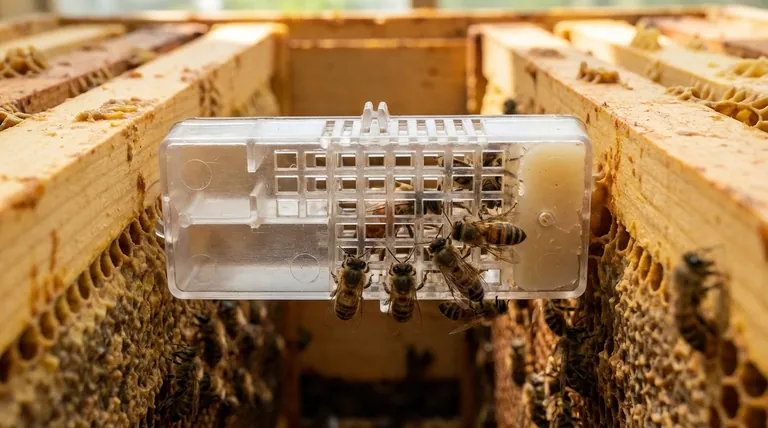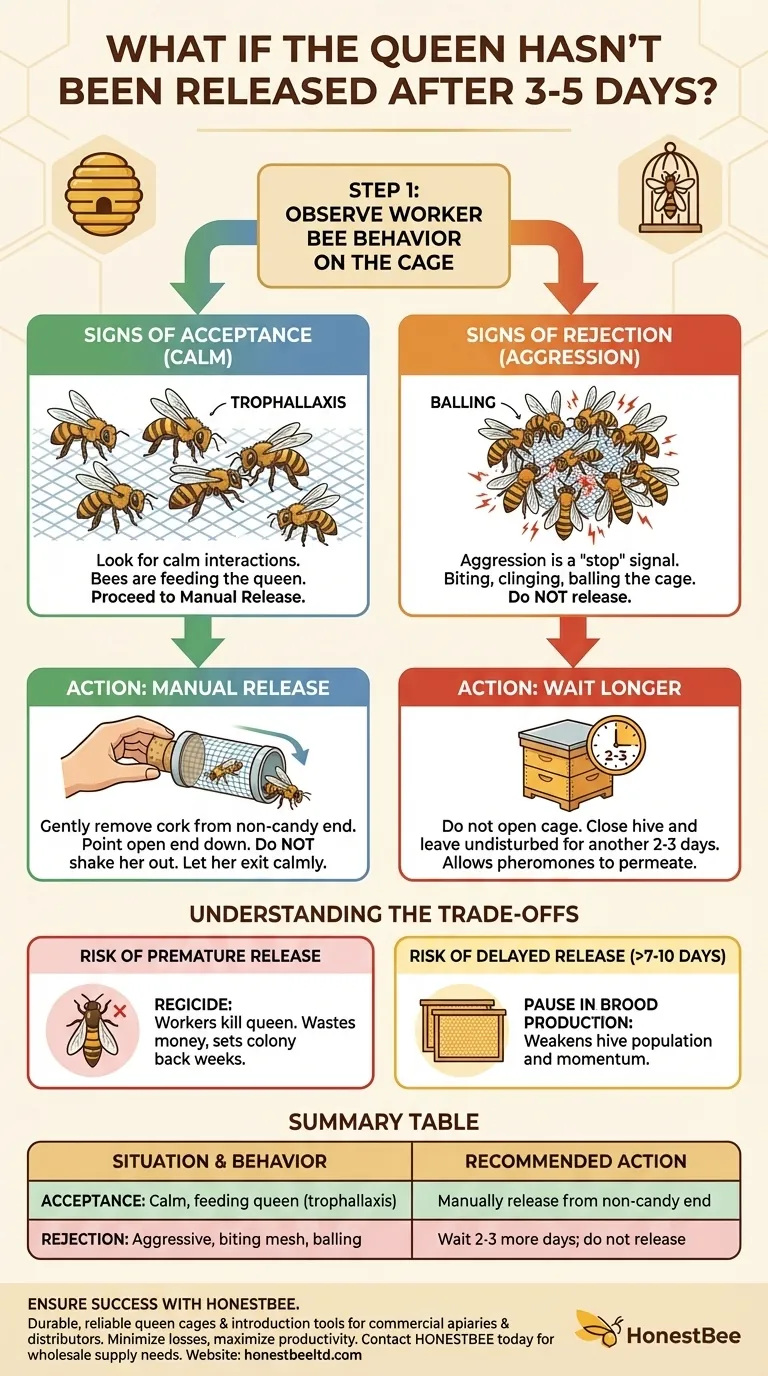In short, if the queen has not been released from her cage after 3-5 days, your first step is to observe the behavior of the worker bees toward her. If they appear calm and are trying to feed her, you can manually release her by opening the cork on the non-candy end of the cage. If they are aggressive, do not release her and give the hive more time.
The decision to manually release a queen is not based on time alone. It must be based on your assessment of the hive's acceptance. Releasing a queen into an aggressive hive will almost certainly result in her death.

Assessing the Hive's Attitude Toward the Queen
Before you open the cage, you must determine if the colony has accepted their new queen. The worker bees' behavior on the cage is your most reliable indicator.
Signs of Acceptance
Look for calm, positive interactions. You will see worker bees walking gently over the cage screen.
They may appear to be feeding the queen through the mesh, a behavior known as trophallaxis. This is a clear sign that they have accepted her as their own.
Signs of Rejection (Aggression)
Aggression is a clear "stop" signal. The most obvious sign is "balling," where worker bees form a tight, angry cluster around the cage, attempting to sting and bite the queen through the screen.
If you see bees clinging to the cage, biting the mesh, and generally acting agitated, they have not accepted her. Releasing her now would be a fatal mistake.
Executing the Correct Action
Your assessment dictates your next move. There are two distinct paths to take.
If Acceptance is Confirmed: Manual Release
If the workers are calm, you can proceed with a "soft" manual release. Gently remove the cork or plug from the opening without the candy.
Point the open end downward toward the frames and allow the queen to walk out on her own time. Do not shake her out. This lets her exit calmly into the colony.
If Rejection is Observed: Wait Longer
If you see signs of aggression, do not open the cage. Simply close up the hive and leave it undisturbed for another 2-3 days.
This extra time allows the queen's pheromones to further permeate the hive, which can calm the workers and lead to eventual acceptance. Your patience here is她的性命攸关.
Understanding the Trade-offs
Queen introduction is a balancing act. Both acting too soon and waiting too long carry risks.
The Risk of Premature Release
The consequences of releasing a queen into an unaccepting hive are severe. The workers will attack and kill her, an event known as regicide.
This action wastes the money you spent on the queen and, more importantly, sets your colony back weeks, as you will have to acquire and introduce another queen.
The Risk of Delayed Release
Leaving a queen caged for an extended period (more than 7-10 days) is also detrimental. The longer she remains caged, the longer the colony is without a laying queen.
This pause in brood production can weaken the hive's population and momentum, making it harder for them to build up strength for a nectar flow or for winter.
Making the Right Choice for Your Goal
Your observation of the hive's behavior is the only data that matters. Let it guide your decision.
- If your primary focus is safety and a successful introduction: Prioritize assessing bee behavior. If you see any aggression, close the hive and wait.
- If the bees are calm but the candy plug is untouched: You can safely perform a manual release by removing the cork from the non-candy end.
- If you have successfully released the queen: Remove the empty cage and wait 7-10 days before your next inspection to check for new eggs, which confirms she is laying.
Ultimately, your role is to intervene only when necessary, based on clear and calm observation.
Summary Table:
| Situation | Worker Bee Behavior | Recommended Action |
|---|---|---|
| Acceptance | Calm, feeding queen through mesh (trophallaxis) | Manually release queen from non-candy end of cage |
| Rejection | Aggressive, biting mesh, balling the cage | Wait 2-3 more days; do not release the queen |
Ensure every queen introduction is a success with the right equipment from HONESTBEE.
Our wholesale-focused operations supply commercial apiaries and beekeeping equipment distributors with durable, reliable queen cages and introduction tools designed for optimal pheromone distribution and hive acceptance.
Let us help you minimize losses and maximize hive productivity. Contact HONESTBEE today to discuss your wholesale supply needs and equip your operation for success.
Visual Guide

Related Products
- Professional Multi-Functional Queen Bee Cage
- Wood and Mesh Push-In Queen Cage
- Durable Galvanized Steel Spring Queen Bee Cage
- Multi-Function Queen Roller Cage and Catcher
- Professional Round Push-In Queen Cage with Metal Tines
People Also Ask
- How should a queen cage be maintained over time? Ensure Queen Introduction Success
- What should be done before removing the queen cage from the hive? Ensure Your New Queen is Accepted & Laying
- What are common mistakes to avoid when using queen cages? Ensure Successful Queen Introduction
- How long does it typically take bees to adjust to a new queen? Master the 2-7 Day Acceptance Window
- What are the components of a standard queen cage? A Guide to Safe Queen Introduction



















